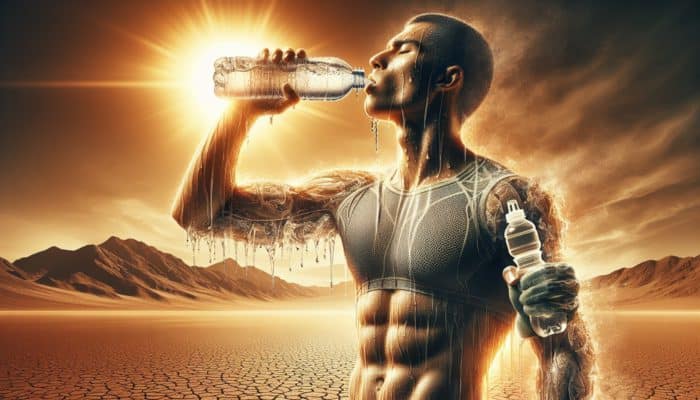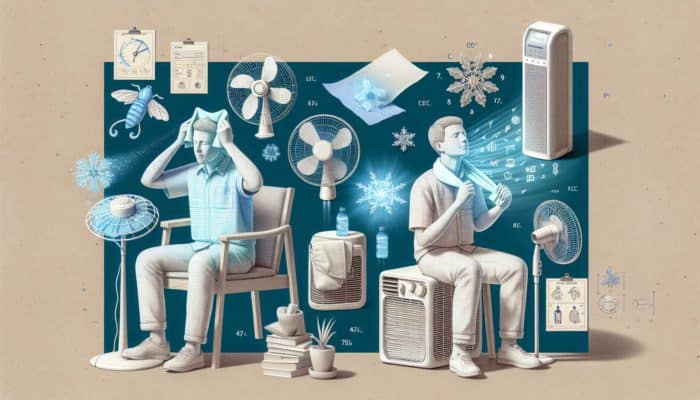Essential Preparation for Coping with Extreme Heat
Effective Hydration Strategies for Hot Climates

Survival in Hot Climates: Maintaining adequate hydration is crucial in high-temperature environments, where the risk of dehydration can escalate rapidly. It is essential to consistently consume water throughout the day, even if you don't feel thirsty. This practice is particularly important because, in extreme heat, your body loses a significant amount of water through perspiration. Consider incorporating electrolyte drinks to replace essential salts lost via sweating, especially after engaging in strenuous activities. These beverages play a crucial role in maintaining your body's salt balance, which is necessary for optimal functioning of vital bodily processes.
To optimise your hydration strategy, make use of a water bottle with measurement markings to monitor your fluid intake. Setting reminders on your mobile device can help you establish and maintain consistent hydration habits. For outdoor activities, a hydration pack can be a practical solution, allowing for hands-free drinking while on the move. It's also important to adjust your fluid intake based on factors such as your activity level, temperature, humidity, and personal sweat rate to ensure you stay adequately hydrated.
Moreover, please pay attention to your consumption of caffeinated or alcoholic beverages, as they can contribute to increased dehydration. Complementing your hydration with water-rich foods, such as fruits and vegetables like watermelon and cucumbers, can significantly enhance your overall fluid intake. Prioritising hydration is essential for maintaining peak body function, particularly during heatwaves or in regions notorious for their high temperatures.
Smart Clothing Choices for Hot Weather Survival
Selecting the appropriate clothing is critical for surviving in hot climates. Lightweight, light-coloured, and loose-fitting garments can dramatically reduce heat exposure. Fabrics made from natural materials, such as cotton or linen, are excellent options, as they allow the skin to breathe and wick moisture away. Avoid dark-coloured clothing, as it absorbs heat, leading to an increase in body temperature. Additionally, consider wearing UV-protective clothing designed to shield you from harmful sun rays.
Accessories like wide-brimmed hats and sunglasses provide extra protection from the sun. Hats can shield your face and neck from direct sunlight, while sunglasses help prevent eye strain and protect against UV damage. A lightweight scarf also proves versatile, doubling as a head wrap or neck cover to enhance your sun protection.
Layering your clothing can be beneficial for adaptability. During the early morning or late evening, temperatures may drop, and having layers allows you to adjust accordingly. Furthermore, consider investing in moisture-wicking undergarments that help keep sweat away from the skin, improving comfort in high temperatures. By making informed clothing choices, you can significantly enhance your comfort level and diminish the risk of heat-related illnesses.
Effective Acclimatization Techniques for Heat Adaptation
Acclimatization is essential for developing tolerance to high temperatures. Gradually exposing yourself to heat helps your body to adapt effectively, thereby minimising the risk of heat exhaustion or heat stroke. If you are moving to a hotter climate or preparing for an outdoor adventure, start by spending short periods in the heat and gradually increase the duration over days or weeks. This method helps your body adjust to rising temperatures and is especially beneficial for athletes and outdoor workers prone to heat stress.
It's crucial to listen to your body during the acclimatization process. Symptoms such as excessive sweating, fatigue, or dizziness may indicate that you need to take a break or reduce your exposure to heat. Hydration is a key component of this process; ensure you are consuming plenty of fluids to support your body’s adjustment. Engaging in light exercise during acclimatization, such as walking or jogging in the heat, can help your body adapt, but always do so in moderation.
Additionally, acclimatization may involve adjusting your activity schedule. If possible, plan your outdoor activities during the cooler parts of the day, such as early mornings or late afternoons. This adjustment can significantly enhance your body's ability to cope with heat. By taking a gradual and considered approach to acclimatization, you greatly increase your chances of thriving in hot environments.
Proven Cooling Techniques to Prevent Overheating

Employing effective cooling techniques is vital for preventing overheating in hot climates. Various methods can be utilised, such as applying damp cloths or cooling towels to pulse points like the neck, wrists, and forehead to help lower your body temperature. Fans can also provide relief by enhancing air circulation, promoting sweat evaporation, and cooling the skin. For those with access to air conditioning, using it can dramatically reduce body temperature and create a more comfortable environment.
Taking cool showers or baths is another effective way to regulate your body temperature. When feeling overheated, immersing yourself in cool water provides immediate relief. If direct access to water is limited, consider creating a makeshift cooling bath by filling a bucket with cool water. Submerging your feet or lower legs can significantly help reduce your core temperature.
An innovative approach involves using ice packs or frozen gel packs wrapped in a cloth and applied to the body. These are particularly effective when placed on areas where blood vessels are close to the skin. It’s advisable to avoid caffeine and alcohol, as these substances can hinder your body’s ability to cool itself effectively. By implementing these cooling techniques, you can maintain your comfort and safety during extreme heat conditions.
Strategic Activity Planning in Hot Weather
Planning your activities during hot weather is crucial for ensuring safety and comfort. Scheduling outdoor activities for the cooler parts of the day, such as early morning or late evening, can significantly reduce heat exposure and the risk of heat-related illnesses. During peak heat hours, typically between 10 AM and 4 PM, it’s advisable to limit strenuous activities, as this is when temperatures are at their highest.
When planning your activities, be mindful of the duration and intensity of your exertion. For instance, if hiking, opt for shorter treks that allow for frequent rest stops in shaded areas. Always carry sufficient water and snacks to sustain your energy levels and hydration. Staying informed about local weather forecasts can also help you anticipate heat waves or sudden temperature spikes, allowing for adjustments to your plans.
Additionally, consider using mobile applications that provide real-time weather updates and heat advisories to assist in planning your outdoor excursions. If you participate in sports or engage in physical activities, be vigilant for the signs of heat exhaustion, such as dizziness, nausea, or excessive sweating. Always prioritise your well-being and be aware of when it’s time to take a break or seek shelter from the heat.
Expert Insights on Thriving in Hot Climates
Real-World Success Stories of Effective Heat Management

Real-world examples of successful heat management showcase the effectiveness of strategic approaches in extreme temperatures. One notable case involved a group of hikers in the Grand Canyon during the peak summer season. They implemented a hydration strategy that included drinking water infused with electrolytes every hour, ensuring they remained hydrated despite the intense heat. They also wore light-coloured, loose-fitting clothing and took regular breaks in shaded areas, enabling them to complete their trek safely.
In another instance, a construction team working in the sweltering heat of Dubai adopted innovative practices to manage heat stress. They scheduled outdoor work for early morning, started shifts at dawn, and utilised portable misting fans and shaded tents for breaks. Consequently, they witnessed a significant decrease in heat-related incidents and an improvement in worker morale.
Key strategies derived from these examples include:
- Regular hydration with water and electrolytes
- Wearing appropriate clothing that reflects heat
- Taking frequent breaks in shaded areas
- Scheduling outdoor activities during cooler times
Implementing these strategies can enhance performance while minimising health risks in hot climates.
What Are the Signs of Heat-Related Illnesses?
Recognising the signs of heat-related illnesses is crucial for timely intervention. Symptoms of heat exhaustion include heavy sweating, weakness, dizziness, nausea, and a rapid pulse. If left untreated, heat exhaustion can escalate to heat stroke, which presents more severe symptoms such as a high body temperature (above 104°F), confusion, and loss of consciousness. Early detection enables prompt action, which can be lifesaving.
It’s essential to monitor your body’s signals and those of others around you when in extreme heat. For instance, if a colleague or companion displays signs of distress, immediately move them to a cooler area, provide fluids, and apply cool cloths to their skin. Understanding these symptoms and taking appropriate action can prevent serious complications and ensure safety.
On a broader scale, public awareness campaigns can help educate communities about the dangers of heat-related illnesses, especially in regions that frequently experience extreme temperatures. Training programmes for outdoor workers, athletes, and recreational enthusiasts can instil knowledge about recognising symptoms and implementing appropriate responses, fostering a culture of safety in hot conditions.
Analyzing the Psychological Impact of Heat
Extreme temperatures can have a profound impact on mental health. High heat levels have been linked to increased irritability, anxiety, and reduced cognitive function. Heat stress can impair decision-making abilities and heighten aggression, posing risks not only to individuals but also to group dynamics in social settings or workplaces.
Research indicates that prolonged exposure to extreme heat can exacerbate pre-existing mental health conditions and lead to increased instances of heat-related violence and accidents. Coping mechanisms become essential in navigating these challenges. Individuals can employ techniques such as mindfulness practices, staying well-hydrated, and maintaining a cool environment to mitigate stress responses.
Creating supportive environments where individuals can openly communicate their discomfort can also help alleviate the psychological strains associated with extreme heat. Employers can consider flexible work hours during heat waves and encourage open discussions about work conditions to ensure a more comfortable and productive work environment. By addressing both the physical and psychological impacts of heat, communities can foster resilience and improve overall well-being in hot climates.
Highlighting the Critical Importance of Hydration in Hot Climates
In hot climates, staying hydrated is crucial for maintaining good health and optimal performance. Water plays a vital role in regulating body temperature and preventing heat-related issues. As temperatures rise, the body relies on sweat to cool itself through evaporation, leading to a significant loss of fluids and electrolytes. Without adequate hydration, the risk of dehydration increases, which can lead to fatigue, confusion, and even heat stroke.
To maintain hydration levels, it’s recommended to drink water before, during, and after exposure to heat. The colour of your urine can serve as a good indicator of hydration status; light yellow signifies adequate hydration, while dark urine indicates dehydration. Consuming water-rich foods, such as fruits and vegetables, can further enhance fluid intake.
It's also essential to recognise that hydration needs can vary based on individual factors, such as age, activity level, and overall health. Athletes or individuals engaged in strenuous activities may require additional fluid intake, particularly when sweating profusely. Keeping a refillable water bottle accessible can encourage consistent drinking habits, ensuring that you are adequately hydrated under challenging heat conditions.
Exploring Technological Advancements for Heat Survival
Innovations in technology continue to enhance survival strategies in hot climates. One significant advancement is the development of cooling fabrics, designed to wick moisture away from the skin and facilitate evaporation, thereby helping to regulate body temperature. These materials are used in a variety of clothing items, ranging from activewear to everyday apparel, providing comfort in extreme heat.
Portable air conditioners and fans have also become essential tools for managing heat stress. Compact and energy-efficient, these devices can provide relief in outdoor settings, making them popular for camping, construction sites, and outdoor events. Furthermore, mobile applications that track temperature and humidity levels help individuals make informed decisions about outdoor activities, ensuring safety during peak heat times.
Moreover, smart hydration systems have emerged, featuring wearable devices that monitor hydration levels and provide real-time reminders to drink water. These advancements are particularly beneficial for athletes and outdoor workers, promoting consistent fluid intake and helping to prevent heat-related health issues. By leveraging these technological innovations, individuals can enhance their comfort and safety in hot climates, significantly improving their overall experience and performance.
How Can You Find Shade and Shelter in Extreme Heat?
Identifying Natural Shade Sources for Relief
Finding natural shade sources is essential for reducing heat exposure in hot climates. Look for trees, rock formations, or any natural structures that can provide relief from direct sunlight. Trees with broad canopies can create a significant cooling effect, while rock formations may offer shelter from radiant heat. In many regions, even small shrubs can provide some respite during peak sun hours.
When exploring trails or outdoor areas, familiarise yourself with the types of trees or plants that are prevalent in the region. For example, in desert environments, look for species like the mesquite tree that can provide the necessary shade. In forested areas, larger trees, such as oaks or pines, can provide substantial coverage.
Additionally, plan your activities around these natural shade sources. Position yourself strategically during breaks, ensuring you’re in the coolest spots available. Creating maps or notes of shaded areas on familiar hiking routes can enhance your preparedness and safety. This awareness is vital in maintaining body temperature and overall comfort during outdoor experiences.
Constructing Temporary Shelters for Enhanced Comfort
Learning to build simple shelters using available materials can greatly enhance your ability to survive in hot climates. Constructing a temporary shelter can protect you from direct sunlight and create a cooler microclimate. Use branches, leaves, or tarps to create shade structures that effectively block sunlight.
When building a shelter, consider the orientation relative to the sun's path. Position your shelter to block the sun during peak hours, ensuring that it captures any breeze to promote air circulation. A makeshift shelter can be quickly fashioned by leaning branches against a sturdy tree or large rock, then covering them with leaves or a tarp to create an insulated shade area.
Furthermore, using ground materials like grass or leaves can provide cushioning from the hot ground, enhancing comfort. If possible, place your shelter near a water source, which can help keep the surrounding area cooler and provide a source of hydration. Understanding these techniques equips you with practical knowledge to safeguard against extreme heat during outdoor activities.
What Are the Best Times to Seek Shelter from the Heat?
The best times to seek shelter from the heat typically fall during peak sun hours, which occur between 10 AM and 4 PM. During this period, the sun’s rays are at their most intense, resulting in elevated temperatures and an increased risk of heat-related illnesses. Planning to limit outdoor activities during these hours can significantly reduce your exposure to heat.
In contrast, early morning and late afternoon are generally cooler times for engaging in outdoor activities. These periods not only offer milder temperatures but also provide a more enjoyable experience. Early mornings often present opportunities for birdwatching or enjoying the tranquillity of nature, while late afternoons can be ideal for leisurely walks or running errands.
If you must be outdoors during peak heat, ensure you have access to adequate shade or cooling options. Consider taking breaks every 30-60 minutes to hydrate and cool down. Recognising the importance of timing and shelter in hot climates can greatly enhance your safety and enjoyment during outdoor adventures.
Managing Heat Effectively During Physical Activity
Pacing Yourself in Hot Conditions to Prevent Heat Strain
Pacing yourself during physical activities in hot climates is essential for preventing heat-related issues. Adjusting your activity level to align with the environmental conditions helps maintain performance while safeguarding your health. Always listen to your body’s signals; fatigue, dizziness, or nausea are clear indicators that you need to slow down or take a break.
When planning physically demanding activities, start at a slower pace and gradually increase the intensity as your body acclimatizes to the heat. Incorporate frequent breaks to rest, hydrate, and cool down. A good rule of thumb is to take breaks every 30-40 minutes during intense activities, especially in high temperatures.
You can also monitor your heart rate as a measure of exertion. If your heart rate rises significantly, it’s a sign to reduce your activity level. Engaging in lighter activities during peak heat times, such as stretching or yoga, can also keep you active without risking overheating. By pacing yourself wisely, you can enjoy outdoor activities while minimising the risks associated with heat stress.
Cooling Techniques During Exercise for Optimal Performance
Implementing effective cooling techniques during exercise is vital for regulating body temperature and enhancing performance in hot climates. Use wet cloths or cooling towels on pulse points, such as the neck, wrists, and forehead, to facilitate cooling. This method can lower your core temperature and help maintain comfort during workouts.
Misting fans have become popular tools for athletes and outdoor workers alike. These devices provide a fine mist of water that cools the air as it evaporates, offering immediate relief from heat. If access to a misting fan is unavailable, consider carrying a spray bottle filled with water to mist your face and body during breaks periodically.
Taking cool showers or baths after exercise is another effective way to lower body temperature. If showering isn’t feasible, immersing your feet or hands in cool water can help cool you down. Post-exercise hydration is equally important; replenish lost fluids and electrolytes to aid recovery and prevent dehydration. By incorporating these cooling techniques, you can enhance your workout experience and maintain safety in extreme heat.
What Foods Are Effective for Heat Management?
Certain foods can be particularly beneficial for managing heat in hot climates. Consuming water-rich foods, such as fruits and vegetables, aids in hydration while providing essential nutrients. Fruits like watermelon, oranges, and strawberries are not only refreshing but also high in water content, helping to replenish lost fluids. Vegetables such as cucumbers and lettuce can similarly contribute to hydration levels.
It’s advisable to avoid heavy, high-protein meals that can increase metabolic heat production in the body. Instead, opt for lighter meals that are easier to digest, such as salads, smoothies, or grilled vegetables. These options promote hydration and provide energy without overburdening your system.
Incorporating electrolyte-rich foods like bananas, spinach, and avocados into your diet can also help maintain electrolyte balance, especially when sweating heavily. Preparing meals ahead of time that focus on these elements can enhance your ability to cope with heat and improve overall well-being. By making conscious food choices, you can support your body’s needs during extreme weather conditions.
Proven Strategies for Survival in Hot Climates
Actionable Steps for Emergency Heat Situations
In emergencies involving heat stroke, immediate action is critical. If someone exhibits symptoms such as confusion, seizures, or unconsciousness, take the following steps:
- Move the individual to a cooler area, preferably indoors or in the shade.
- Call emergency services immediately if the person is unresponsive or in severe distress.
- Loosen or remove any tight clothing to allow for proper cooling.
- Use cool, wet cloths or ice packs on pulse points to lower temperature.
- Encourage the person to drink cool water if they are conscious and able to swallow.
Acting swiftly can make a lifesaving difference in heat-related emergencies. Understanding these procedures equips you with the knowledge to respond effectively in critical situations.
How Can You Use Technology to Your Advantage in Heat Management?
Utilising technology can significantly enhance your ability to manage heat during outdoor activities. Weather apps provide real-time updates on temperature and humidity levels, allowing you to plan your day effectively. Many of these apps offer alerts for extreme heat warnings, enabling you to make informed decisions about outdoor endeavours.
Wearable devices that track hydration levels can also be invaluable. Some modern fitness trackers come equipped with features that remind you to drink water based on your activity and sweat levels. This proactive approach can help prevent dehydration and heat-related illnesses.
Additionally, consider investing in cooling vests or portable fans designed for outdoor use. These tools can provide immediate relief in extreme conditions, ensuring your safety and comfort. Embracing these technological advancements allows you to navigate hot climates with confidence and ease.
Expert Analysis on Long-Term Heat Adaptation
Long-term adaptation to heat involves physiological adjustments that enhance your body’s ability to cope with high temperatures. Over time, individuals exposed to consistent heat can develop increased sweat production, which enables more effective temperature regulation. This adaptation can lower the risk of heat-related illnesses as your body becomes more efficient at regulating its temperature.
Additionally, long-term exposure can lead to improved cardiovascular fitness, as the heart adapts to pumping blood more effectively in high temperatures. The body also becomes more adept at retaining electrolytes and fluids, which is crucial for maintaining balance during extreme heat.
To facilitate this adaptation process, gradually increase your exposure to heat by engaging in outdoor activities consistently over days or weeks. This method allows your body to adapt naturally. Furthermore, maintaining hydration and nutrition during this period significantly contributes to successful long-term acclimatization, ultimately enhancing your overall resilience in hot climates.
What Clothing Choices Enhance Comfort in Hot Climates?
Choosing the right clothing for hot climates can significantly enhance comfort and safety. Opt for lightweight, breathable fabrics such as cotton or linen. These materials allow for air circulation and wick moisture away from the skin, which is critical for cooling. Furthermore, light colours reflect heat rather than absorbing it, making them more suitable for warm conditions.
Loose-fitting garments are essential, as they facilitate air movement around the body. Consider wearing moisture-wicking undergarments to help keep sweat away from your skin. Additionally, long sleeves and pants made from lightweight, UV-protective fabric provide extra sun protection while still allowing for breathability.
Accessories such as wide-brimmed hats and UV-blocking sunglasses are also indispensable. They protect your skin and eyes from direct sunlight, further enhancing your ability to navigate hot environments. By making informed clothing choices, you can significantly improve your comfort and safety in hot climates.
The Crucial Importance of Hydration and Electrolyte Balance
Maintaining hydration and electrolyte balance is crucial for maintaining good health in hot climates. Drinking water regularly helps prevent dehydration, which can lead to severe health complications. It’s crucial to understand that water alone may not always suffice; incorporating electrolyte drinks can replace salts lost through sweat, thus ensuring optimal bodily functions.
Electrolytes such as sodium, potassium, and magnesium play significant roles in muscle function and nerve signalling. Consuming electrolyte-rich foods—such as bananas, nuts, and leafy greens—can further bolster your body’s defenses against heat stress.
Establishing a routine for hydration is vital. Carry a refillable water bottle and aim to drink before you feel thirsty. Setting hydration goals based on activity level and environmental factors can help maintain balance. By prioritising both hydration and electrolyte intake, you can enhance your performance and comfort in high-temperature conditions.
Essential Gear for Surviving in Hot Weather
Must-Have Items for Your Hot Weather Survival Kit
Equipping yourself with essential gear is crucial for surviving in hot weather conditions. Must-have items include sunscreen, which provides necessary protection from harmful UV rays, minimising the risk of sunburn and skin damage. A wide-brimmed hat can shield your face and neck from direct sunlight, while sunglasses protect your eyes from UV radiation.
A hydration pack is another vital item, enabling you to carry sufficient water while keeping your hands free. Additionally, lightweight, moisture-wicking clothing can enhance comfort and safety by allowing sweat to evaporate and air to circulate.
Consider including a portable fan or misting device in your kit. These gadgets can provide immediate relief and help cool you down in extremely hot weather. A first-aid kit tailored for heat-related issues, containing items like electrolyte tablets and cooling packs, is also advisable. By assembling this gear, you can enhance your preparedness and safety in hot climates.
Maintaining and Using Your Gear Effectively
Regular maintenance of your gear is essential for maximising its effectiveness in hot weather conditions. Periodically check your equipment for wear and tear, ensuring that items such as hydration packs, fans, and cooling devices are in working order. Proper cleaning and storage methods can extend the life of your gear, making it more reliable in critical situations.
When using your gear, familiarise yourself with the manufacturer's instructions to optimise performance. For instance, learning how to adjust your hydration pack for comfort and efficiency can prevent issues during outdoor activities. Practice setting up your cooling devices to ensure that you can use them quickly and effectively when needed.
Additionally, consider creating a checklist of essential items you need for specific activities or environments. This organisation will help ensure that you are always prepared for the challenges of hot climates. By maintaining and using your gear effectively, you can enhance your safety and comfort in extreme heat.
What Innovations Are Enhancing Heat Survival Strategies?
Innovative technologies are continually improving survival strategies in hot climates. Advanced fabrics that offer cooling properties are one notable development. These materials are designed to enhance breathability, wick moisture away from the skin, and even lower skin temperature through evaporation.
Portable air conditioning units and personal cooling devices have also become more accessible, providing individuals with immediate relief from high temperatures. These advancements are particularly beneficial for outdoor workers or those engaged in recreational activities in extremely hot conditions.
Moreover, smart wearable technology has emerged, tracking hydration levels and providing users with real-time feedback. These devices can remind individuals to drink water based on their activity level and environmental conditions, which is crucial for maintaining hydration in hot climates.
By embracing these innovations, individuals can enhance their comfort and safety while navigating the challenges presented by extreme heat, ultimately improving their overall experience in hot environments.
Frequently Asked Questions About Heat Management
What is the best way to stay hydrated in hot weather?
Drink water consistently throughout the day, even if you don’t feel thirsty. Consider electrolyte drinks to replenish salts lost through sweating, and consume water-rich foods like fruits and vegetables.
How should I dress in extremely hot weather?
Wear lightweight, light-coloured, and loose-fitting clothing to promote air circulation and reflect heat. Opt for natural fabrics like cotton or linen and use accessories like hats and sunglasses for additional sun protection.
What are the signs of heat exhaustion?
Signs of heat exhaustion include heavy sweating, weakness, dizziness, nausea, and rapid heartbeat. If you experience these symptoms, it’s essential to cool down and hydrate immediately.
How can I acclimatise to hot weather effectively?
Gradually increase your exposure to heat over days or weeks, starting with short periods outdoors. Stay hydrated and engage in light activities to help your body adjust.
What cooling techniques can I use during exercise?
Utilise wet cloths on pulse points, take breaks in shaded areas, and use misting fans or portable cooling devices to help regulate body temperature during physical activities.
How can technology help manage heat stress?
Weather apps provide real-time temperature updates, while wearable devices can track hydration levels and remind you to drink water, enhancing your ability to manage heat effectively.
What should I do in case of heat stroke?
If someone shows signs of heat stroke, move them to a cooler area, call for emergency help, loosen their clothing, apply cool cloths, and encourage them to drink cool water if they are conscious.
What foods are best for staying cool in hot weather?
Hydrating foods, such as watermelon, cucumbers, and oranges, are ideal for managing heat. Avoid heavy, high-protein meals that can increase metabolic heat.
How can I create shade when outdoors?
Identify natural shade sources, such as trees or rock formations, and consider constructing temporary shelters using materials like branches and leaves to block direct sunlight.
What items should be included in a survival kit for hot weather?
Include sunscreen, a wide-brimmed hat, sunglasses, a hydration pack, moisture-wicking clothing, and a portable fan or misting device in your survival kit for hot climates.
Explore our world on X!
Shtf Fire-Starting: Essential Techniques and Tools
Mastering the Fundamental Concepts of SHTF Fire-Starting Comprehending the Essential Fire Triangle Shtf Fire-Starting: The fire triangle is a fundamental concept that anyone serious about SHTF fire-starting must understand. This triangle comprises three vital elements: heat, fuel, and oxygen. Mastering these components is essential for successful fire-starting in any scenario. Without heat, you cannot ignite […]
Surviving A Bear Attack: Essential Tips
Comprehensive Guide to Bear Behaviour and Safety Exploring the Various Types of Bears Surviving A Bear Attack: Understanding the distinct species of bears is vital for effectively predicting their behaviour and interactions with humans. Globally, there are eight species of bears: American black bears, grizzly bears, polar bears, Asian black bears, Andean bears, spectacled bears, […]
Survival in Remote Areas: Essential Tips and Techniques
Essential Preparations for Thriving in Remote Survival Scenarios Choosing and Packing Your Survival Gear Wisely Survival in Remote Areas: When embarking on an adventure into remote areas, it is absolutely vital to select and pack the appropriate gear to ensure your survival. Every single item in your backpack should have a specific purpose, equipping you […]
Primitive Shelter Designs: A Comprehensive Guide
Exploring the Fundamentals of Primitive Shelter Designs What Constitutes Primitive Shelters? Primitive Shelter Designs: Primitive shelters represent the foundational structures that have been essential for human survival and habitation throughout history. These shelters are notable for their simplicity and the use of readily available natural materials, often requiring only basic tools for their assembly. Found […]








Your emphasis on consistent hydration is spot on, especially considering how easily we forget to drink water until it’s too late. I’ve noticed that in really hot climates, people often overlook how much they sweat, leading to significant hydration deficits without even realizing it.
This post touches on such an important aspect of our daily lives, especially as we experience hotter summers and changing climates. I find the idea of consistent hydration particularly relevant, as it reminds me of my own experiences hiking during heat waves. There were times I underestimated my water needs and ended up feeling drained much quicker than expected.